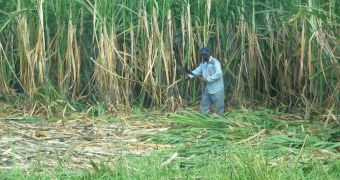This is the first chemical to which we get addicted. What would we do without sugar? Many types of dishes and sweets should be changed. Today, eating sugar is part of the daily menu, and the stuff is delivered by a worldwide industry, driving millions of people from Cuba to India, Brazil to Africa and Australia.
Sugar is obtained mainly from two crops. In tropical areas, the sugarcane is the main crop and delivers 65 % of the world's sugar production. The rest is delivered by the sugar beet, which grows in colder areas (Europe and North America). The sugar obtained from the two plants is chemically identical.
You can say sugarcane modeled the world in a manner that few plants did it. Imagine that millions of Black people in Brazil, Antilles and other areas of Americas were brought as slaves for the sugarcane plantations. This because the sugarcane in other times (and still today in developing countries) required a lot of work hand, as the cane was cut manually with the machetes. Today, in developed countries (like in Australia, which cultivates the plant in northeast), thus cultivation is mechanized.
The sugarcane originates from the tropical forests of southeastern Asia and New Guinea. It is a giant in the family of the grasses, which also includes cereals and bamboo. All these plants produce sugar in their leaves through photosynthesis, but the sugarcane stores an enormous quantity of it as sweet juice into its fibrous stems.
The cultivation of the sugarcane was widespread in ancient India. In 327 BC, the scribes of the invading armies of Alexander the Great wrote that the locals "chewed a wonderful cane, that produced a kind of honey without the help of the bees".
During the 15th century, the explorations and the world development spread the sugarcane cultivation, which now counts with thousands of varieties in 80 countries, delivering an annual production of one billion tones.
Mature stems are cut in pieces 40 cm (1.3 ft) long and planted at distances of 1.5 m (5 ft) one from another. From each piece grows a bundle of 8-12 stems of sugar cane which mature in 12-16 months. The stems can be 4 m (13 ft) tall.
Sugar cane is attacked by many diseases and pests, like beetles or rodents. Efforts to combat them sometimes succeeded, but in other times resulted in great failures. In 1935, eager to annihilate the sugarcane beetle, authorities introduced the can toad from South America into northern Queensland. Unfortunately, the toad preferred other preys, easier to catch, flourished, and turned into a pest continuously gaining new territories.
Before the harvesting, farmers give fire to the mature field of sugar cane. The burning eliminates leaves and other useless matters, considered a burden for harvesting and processing of the cane.
Recently, the method of harvesting the cane without burning it is the more recommended. This method increases the amount of extracted sugar, leaving behind a protective layer which combats the installation of weeds and soil erosion.
Manually, a worker can cut 5 tones of cane daily, machines can now crop 300 tones daily. A sugarcane crop can be exploited for several years till the sugar production decreases and the plants must be replaced. As the sugar deteriorates quickly, the cut cane is rapidly processed. In fabrics, the stems are smashed and squeezed of their sweet juice out of the fibers. The remaining fibers are drought and used for fueling the whole machinery of the fabric and the surplus can be sold to paper mills or construction material fabrics.
The impurities are eliminated from the brute juice till obtaining a clear liquid. The recycled impurities can be used as fertilizers. Another secondary product of the sugar processing is the molasses, used as food for cattle or for distilling rum and industrial alcohol.
Trough the boiling and water evaporation from the clear liquid is obtained a concentrated syrup, punctuated by small sugar crystals. The crystals grow till achieving the right size. They are extracted from this mixture and dried. The result will be the brute sugar, brown colored. Subsequent processing will lead to the refined sugar, snow white.

 14 DAY TRIAL //
14 DAY TRIAL //